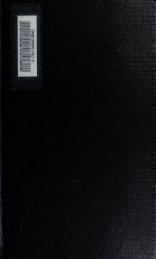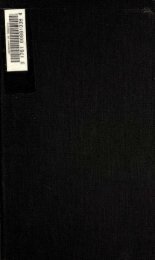Texts from the Buddhist canon : commonly known as Dhammapada
Texts from the Buddhist canon : commonly known as Dhammapada
Texts from the Buddhist canon : commonly known as Dhammapada
Create successful ePaper yourself
Turn your PDF publications into a flip-book with our unique Google optimized e-Paper software.
INTRODUCTION. 23<br />
instance, about 220 a.d, should not be <strong>the</strong> very ones<br />
attributed to Dharmatrata at le<strong>as</strong>t 70 B.C. I am sorry<br />
that I have not been able to trace any agreement<br />
between <strong>the</strong>se stories and those given by Buddhaghosha.<br />
Mr. FausboU's notes are mostly mere transcriptions in<br />
Pali, but yet enough may be ga<strong>the</strong>red <strong>from</strong> <strong>the</strong>se, even by<br />
one who is not a P§,li scholar, to make it clear that <strong>the</strong><br />
stories to which he refers are not <strong>the</strong> same <strong>as</strong> those I<br />
have translated ; <strong>the</strong> solution of this difficulty will have<br />
to be sought in <strong>the</strong> hint before alluded to, viz., that <strong>the</strong><br />
parables were invented to suit <strong>the</strong> text of <strong>Dhammapada</strong><br />
ra<strong>the</strong>r than vice, versd (Max Miiller's Dh. cvi. n.). I shall<br />
leave any fur<strong>the</strong>r observations on <strong>the</strong> Gath&s which accompany<br />
<strong>the</strong> stories, for <strong>the</strong> notes that will be found in <strong>the</strong><br />
book itself.<br />
The third version of <strong>Dhammapada</strong> <strong>known</strong> in China is<br />
entitled " Chuh-yau-king," which may signify <strong>the</strong> Sutra<br />
of " <strong>the</strong> Dawn," or " birth of Light." ^ This work is very<br />
much expanded, consisting^ in fact, of seven volumes,<br />
comprising twenty hiouen or books. It is still referred to<br />
Arya Dharmatrata <strong>as</strong> its author ; its translator w<strong>as</strong> Chu-<br />
fo-nien (or, Fo-nien (Buddh<strong>as</strong>mriti ?) <strong>the</strong> Indian {Chv)<br />
who lived during <strong>the</strong> Yaou-Tsin period, about 410 A.D.<br />
In <strong>the</strong> preface to this version we are told that Dharmatr§,ta<br />
w<strong>as</strong> uncle of V<strong>as</strong>umitra, and that he w<strong>as</strong> <strong>the</strong> original compiler<br />
of tjhe stanz<strong>as</strong> and stories <strong>known</strong> <strong>as</strong> Fa-kheu-King<br />
(<strong>Dhammapada</strong>). It informs us, moreover, that <strong>the</strong> old<br />
term "pi-u," i.e., AvadS,n<strong>as</strong>, w<strong>as</strong> <strong>the</strong> same <strong>as</strong> " <strong>the</strong><br />
Dawn," and that <strong>the</strong>se Avadan<strong>as</strong> composed <strong>the</strong> sixth of<br />
<strong>the</strong> twelve sections (aiig<strong>as</strong>) that made up <strong>the</strong> whole<br />
1 In <strong>the</strong> Encyclopedia <strong>known</strong> <strong>as</strong> verses, I observe, are repeated in<br />
Chi-yuen-f5rpao-kha'n-tung-tsung-liu each alternate section, <strong>as</strong> in a "re-<br />
Catalogue, C<strong>as</strong>e xci.), this work is frain." The Colophon explains that<br />
also c^ed " Chuh-yau-lun,'' Kiotien this work belongs to <strong>the</strong> cl<strong>as</strong>s <strong>known</strong><br />
9, fol. 't'. This book Reserves atten- <strong>as</strong> "In-tou-cho-tsah," i.e., "Indian<br />
tion. It would well repay translation, Miscellanies,'' perhaps <strong>the</strong> Khuddakaif<br />
<strong>the</strong> study of Chinese <strong>Buddhist</strong> nikdya of <strong>the</strong> South,<br />
books ever commands notice. The





